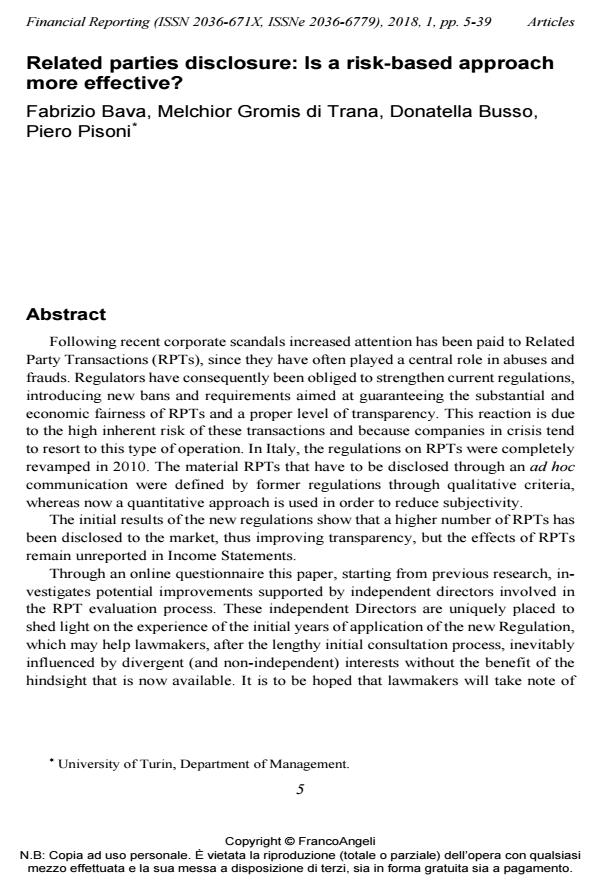Related parties disclosure: Is a risk-based approach more effective?
Journal title FINANCIAL REPORTING
Author/s Fabrizio Bava, Melchior Gromis di Trana, Donatella Busso, Piero Pisoni
Publishing Year 2018 Issue 2018/1
Language English Pages 35 P. 5-39 File size 284 KB
DOI 10.3280/FR2018-001001
DOI is like a bar code for intellectual property: to have more infomation
click here
Below, you can see the article first page
If you want to buy this article in PDF format, you can do it, following the instructions to buy download credits

FrancoAngeli is member of Publishers International Linking Association, Inc (PILA), a not-for-profit association which run the CrossRef service enabling links to and from online scholarly content.
Following recent corporate scandals increased attention has been paid to Relat-ed Party Transactions (RPTs), since they have often played a central role in abuses and frauds. Regulators have consequently been obliged to strengthen current regu-lations, introducing new bans and requirements aimed at guaranteeing the substantial and economic fairness of RPTs and a proper level of transparency. This reaction is due to the high inherent risk of these transactions and because companies in crisis tend to resort to this type of operation. In Italy, the regulations on RPTs were completely revamped in 2010. The material RPTs that have to be disclosed through an ad hoc communication were defined by former regulations through qualitative criteria, whereas now a quantitative approach is used in order to reduce subjectivity. The initial results of the new regulations show that a higher number of RPTs has been disclosed to the market, thus improving transparency, but the effects of RPTs remain unreported in Income Statements. Through an online questionnaire this paper, starting from previous research, in-vestigates potential improvements supported by independent directors involved in the RPT evaluation process. These independent Directors are uniquely placed to shed light on the experience of the initial years of application of the new Regula-tion, which may help lawmakers, after the lengthy initial consultation process, in-evitably influenced by divergent (and non-independent) interests without the bene-fit of the hindsight that is now available. It is to be hoped that lawmakers will take note of these results and fine-tune the regulations accordingly, without necessarily abandoning the quantitative approach, in order to increase the transparency of the information made available on RPTs.
Keywords: Related party transactions, disclosure, IAS 24, quantitative criteria.
Fabrizio Bava, Melchior Gromis di Trana, Donatella Busso, Piero Pisoni, Related parties disclosure: Is a risk-based approach more effective? in "FINANCIAL REPORTING" 1/2018, pp 5-39, DOI: 10.3280/FR2018-001001